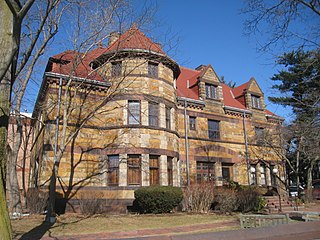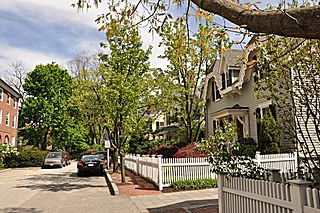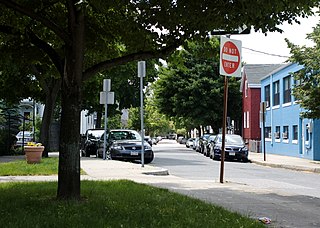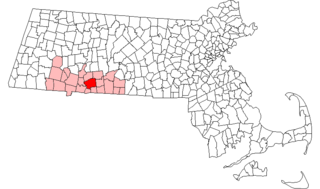
The Theodore W. Richards House is a National Historic Landmark at 15 Follen Street in Cambridge, Massachusetts. Built in 1900, it was the home until his death of Theodore William Richards (1868–1928), the first American to be awarded the Nobel Prize in Chemistry. Richards was a leading experimental chemist of his day, measuring the atomic weights of a large number of elements. He was also responsible for the growth of Harvard University's graduate chemistry program to one of the finest in the nation. The house was designated a National Historic Landmark in 1976.

The Edwin Abbot House, also known as the Zabriskie House, is an historic house at 27 Garden Street in Cambridge, Massachusetts. Built in 1889 to a design by Longfellow, Alden & Harlow, it is a prominent local example of residential Richardsonian Romanesque architecture. It has served as the principal building of the Longy School since 1937. It was listed on the National Register of Historic Places in 1979, and included in the Follen Street Historic District in 1986.

The Ash Street Historic District Cambridge, Massachusetts is a residential historic district on Ash Street and Ash Street Place between Brattle and Mount Auburn Streets in Cambridge, Massachusetts, off Brattle Street just west of Harvard Square. The district consists of ten well-preserved houses, most of which were built between 1850 and 1890. The district was listed on the National Register of Historic Places in 1982.

The Berkeley Street Historic District is a historic district on Berkeley Street and Berkeley Place in Cambridge, Massachusetts. It encompasses a neighborhood containing one of the greatest concentrations of fine Italianate and Second Empire houses in the city. It was listed on the National Register of Historic Places in 1982, with a substantial increase in 1986.

Brattle Hall is a historic building along Brattle Street near Harvard Square in Cambridge, Massachusetts. It was constructed in 1889 for the Cambridge Social Union – established in 1871 – when that organization moved into the adjacent William Brattle House that year. Brattle Hall was built to house the organization's library, and to provide a space for larger meetings and social functions. Brattle Hall was designed by Longfellow, Alden & Harlow, originally in the Dutch Colonial Revival style, but it acquired more of a Colonial Revival feel with the 1907 addition of brick ends, designed by Charles Cogswell.

Cloverden is an historic house at 29 Follen Street in Cambridge, Massachusetts. It is a 2+1⁄2-story wood-frame structure, five bays wide, with a side-gable roof, two asymmetrically placed chimneys, and clapboard siding. A single-story porch extends across the front, supported by Doric columns. The Greek Revival house was built in 1837.

The Follen Street Historic District is a historic district in Cambridge, Massachusetts, just northwest of the Cambridge Common. Follen Street is a quiet residential street, isolated from through streets by large masonry buildings that front on Waterford Street and Garden Street. All but three of the houses on the street were built no later than 1900, and show a remarkable quality of workmanship, despite being diverse in their styles. A number of the houses are specifically associated with educators, including a number of Harvard University professors. The Edwin Abbot House at 1 Follen Street is now the main building of the Longy School of Music of Bard College, and is separately listed on the National Register. Other houses listed separately include the Theodore W. Richards House at 15 Follen, the Second Waterhouse House at 9 Follen, and 10 Follen Street.

The Harvard Houses Historic District is a historic district encompassing seven of Harvard College's residential houses. The district is roughly bounded by Mt. Auburn, Grant, and Cowperwaite Streets, Banks Street and Putman Avenue, Memorial Drive, and JFK Street in Cambridge, Massachusetts. The contributing buildings to the district are predominantly residential dormitory buildings which were constructed between 1913 and 1930, and are Georgian Revival in style. There are three small residential buildings which were built in the 18th and 19th centuries, and a number of non-contributing later buildings, including among others the towers of Leverett House and the modern portion of Quincy House at 58 Plympton Street. The buildings are an imposing presence in the streetview of Memorial Drive between Western Avenue and the Anderson Memorial Bridge, but their massing is interrupted by mature tree plantings, and they are organized to provide courtyards and quadrangles in the interior of the district.

The Hastings Square Historic District is a historic district that encompasses Hastings Square, a small city park in Cambridge, Massachusetts, and the residential properties that abut it. The houses that line the streets across from the park are among the finest Queen Anne houses in the city. These properties were built between 1869 and 1892, and include two houses known to be designed by architects. The Queen Anne/Shingle style house at 302 Brookline Avenue was built in 1887 to a design by Rand & Taylor, and the 1892 Queen Anne house at 75 Henry Street was designed by Hartwell and Richardson.

The Hubbard Park Historic District encompasses a residential development and park west of Harvard Square in Cambridge, Massachusetts. The area was originally the estate of Gardiner Hubbard, who had a 6-acre (2.4 ha) estate and house on nearby Brattle Street. In the 1880s Hubbard commissioned architects to build a ring of high quality homes around his mansion, which was demolished in 1939 and is now the site of Hubbard Park. The houses in this development are now located on Mercer Circle, Sparks Street, and Hubbard Park Road.

The Norfolk Street Historic District is a historic district at Norfolk Street between Suffolk and Bishop Allen Streets in Cambridge, Massachusetts. It encompasses two distinct phases of 19th century residential development in the city: a period in the 1840s when a series of Greek Revival cottages was built, and the 1880s, when four-story "hotel" construction predominated. Many of the Greek Revival cottages have been altered, although that at 73 Norfolk is particularly well preserved. The district features works by James Fogerty and other local architects.

The Old Cambridge Historic District is a historic district encompassing a residential neighborhood of Cambridge, Massachusetts that dates to colonial times. It is located just west of Harvard Square, and includes all of the properties on Brattle Street west of Mason Street to Fresh Pond Parkway, all of the properties on Mason Street and Elmwood Avenue, and nearby properties on Craigie Street. The district includes five National Historic Landmarks: Elmwood, the Reginald A. Daly House, the Oliver Hastings House, the Mary Fiske Stoughton House, and the Longfellow House–Washington's Headquarters National Historic Site, as well as several other houses listed separately on the National Register. The district follows the general route of the Watertown Path, an early colonial road that supposedly followed a Native American trail. This portion of the way became known as Tory Row during the American Revolution, because many of the fine mansions lining it were owned by Loyalists. In the 19th and early 20th centuries it continued by a fashionable location, and now features a number of architecturally significant buildings. It includes 215 contributing buildings and one other contributing sites over an area of 52 acres (21 ha). One included building is the Cambridge Historical Society's offices, which are in the NRHP-listed Hooper-Lee Nichols House, located at 159 Brattle Street.

The Old Cambridgeport Historic District is a historic district along Cherry, Harvard and Washington Streets in Cambridge, Massachusetts. It contains some of the oldest surviving houses north of Massachusetts Avenue in the Cambridgeport section of the city. It includes the entire block of Cherry Street between Harvard and Washington Streets, as well as a few buildings on those two streets. The oldest houses are the Samuel Fay House and the Margaret Fuller House.

The Winter Street Historic District is a historic district on Winter Street in Cambridge, Massachusetts. Centered on the junction of Winter Street with Sciarappa Street, the district includes sixteen houses, fourteen of which were worker's cottages built before 1854. Many early residents of the area were employed by the New England Glass Company, whose factory was nearby. The district is the best-preserved streetscape of such worker housing in East Cambridge.

The Shady Hill Historic District is a historic district roughly bounded by Museum, Beacon and Holden, and Kirkland Streets, and Francis Avenue in Cambridge, Massachusetts. The district encompasses a residential area that is one of the city's most homogeneous neighborhoods of the second half of the 19th century. Located just east of the Harvard University campus, the area is characterized by large lot sizes and winding roads, with mature trees providing shade. The houses in the district are predominantly Queen Anne and Colonial Revival in character.

The Second Waterhouse House is an historic house at 9 Follen Street in Cambridge, Massachusetts. The 2+1⁄2-story wood-frame house was built on 1844, and is the most quintessentially Greek Revival house in the Follen Street Historic District. It was built by Benjamin Waterhouse, and is one of the earliest houses built on the street. Of particular historical interest is the assortment of heating systems that have been installed in the house since 1853, remnants of some of which are still found in the house's basement.

The Salem–Auburn Streets Historic District is a residential historic district at Salem and Auburn Streets in Cambridge, Massachusetts. The district includes a collection of houses that is among the oldest in the Cambridgeport section of the city, and includes most of the houses on two blocks of these streets. The district was added to the National Register of Historic Places in 1982.

Fort Hill Historic District is a historic district roughly on South Street between Lyman to Monroe in Northampton, Massachusetts.

The Marblehead Historic District is a 2,300-acre (930 ha) historic district roughly bounded by Marblehead Harbor, Waldron Court, Essex, Elm, Pond, and Norman Streets in Marblehead, Massachusetts. Among its notable features are Fort Sewall, a coastal fortification with origins dating to 1644, and two National Historic Landmarks, the General John Glover House, the Jeremiah Lee Mansion, and the Simon Bradstreet House.

This is a list of the National Register of Historic Places listings in Springfield, Massachusetts.























